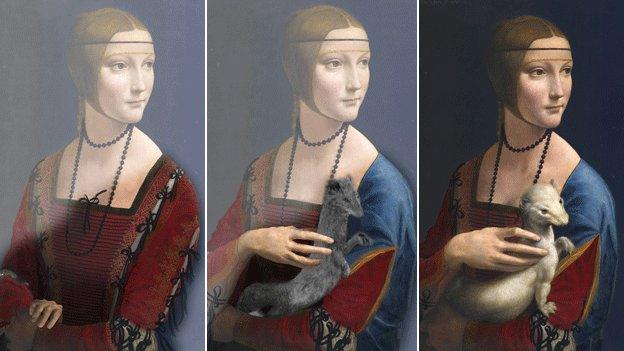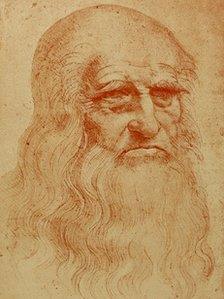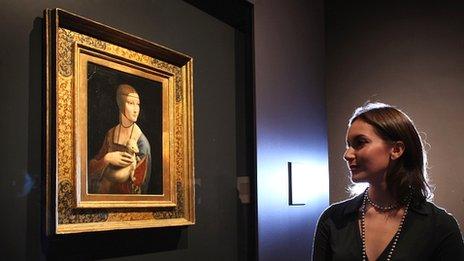Leonardo Da Vinci 'painted three Ermine portraits'
- Published

Three different versions of the painting were produced
A French scientist has revealed a major new discovery about one of Leonardo da Vinci's most famous paintings, shedding new light on his techniques.
Engineer Pascal Cotte has spent three years using reflective light technology to analyse The Lady with an Ermine.
Until now, it was thought the 500-year-old painting had always included the ceremonial animal.
Mr Cotte has shown the artist painted one portrait without the ermine and two with different versions of the fur.
Leonardo experts have described the new findings as "thrilling" and said the discovery raises new questions about the painting's history.
The BBC's Roya Nikkhah: "The history of Leonardo's masterpiece is now being rewritten"
The Lady with an Ermine is a portrait of Cecilia Gallerani, a young woman in the Milanese court who was mistress to Ludovico Sforza, the Duke of Milan.
'Changing his mind'
It is believed to have been painted between 1489 and 1490.
The Duke was Leonardo's main patron during his 18 years in the city, and he was nicknamed "the white ermine".

This red chalk drawing circa 1509 is widely accepted as a Leonardo self-portrait
Mr Cotte, who is a co-founder of Lumiere Technology in Paris, has pioneered a new technique called Layer Amplification Method (LAM).
It works by projecting a series of intense lights on to the painting. A camera then takes measurements of the lights' reflections and from those measurements, Mr Cotte is then able to analyse and reconstruct what has happened between the layers of the paint.
Following the discovery, new theories have now been applied to the well-known portrait, including a suggestion the artist may have introduced the ermine into the painting to symbolise Gallerani's lover, later enhancing the animal to flatter his patron.
Another theory is that Gallerani asked the artist to add the animal into the painting, so that the Milanese court was made fully aware of her relationship with the Duke.
Polish home
Mr Cotte said: "The LAM technique gives us the capability to peel the painting like an onion, removing the surface to see what's happening inside and behind the different layers of paint.
"We've discovered that Leonardo is always changing his mind. This is someone who hesitates - he erases things, he adds things, he changes his mind again and again."
Martin Kemp, Emeritus Professor of the History of Art at the University of Oxford, said: "What Pascal Cotte is revealing in France is remarkable.
"It tells us a lot more about the way Leonardo's mind worked when he was doing a painting. We know that he fiddled around a good deal at the beginning, but now we know that he kept fiddling around all the time and it helps explain why he had so much difficulty finishing paintings.
"Leonardo is endlessly fascinating, so getting this intimate insight into his mind is thrilling."
The painting belongs to the Czartoryski Foundation and is usually on display at the National Museum in Krakow, Poland. It is currently hanging in nearby Wawel Castle while the Museum undergoes renovation.
The Lady with an Ermine was one of the star attractions at the National Gallery's 2011 exhibition, Leonardo Da Vinci: Painter at the Court of Milan.
The painting has previously undergone several examinations using X-ray and infra-red analysis.
- Published9 November 2011

- Published8 November 2011